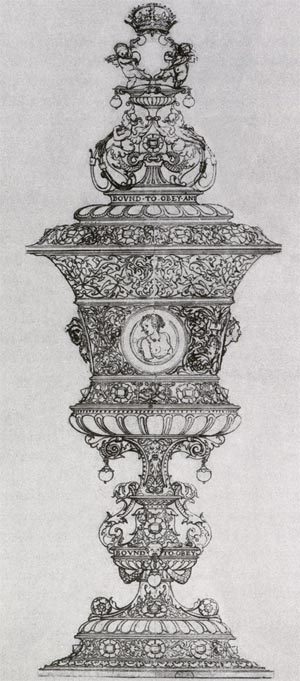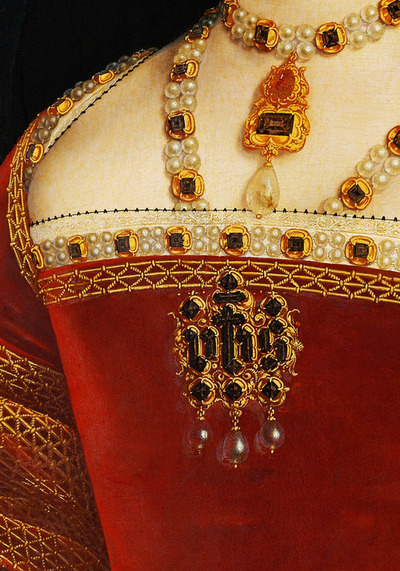A good marriage during the Tudor era was one which brought prosperity to the family of the bride and groom. For the groom, it might be a good dowry and for the bride, advancement in status or in valuable connections for her family. The emotions of the couple involved were not really a consideration. They might never have met until they stood before the altar.
The higher up the social class, the less likely a person was to have choice in their spouse, and the younger they were likely to marry.
Margaret Beaufort wed her first husband at twelve, the minimum age for a full marriage, according to the church.
When two families decided their children should wed, a period of negotiation began. The father of the bride was expected to pay a dowry commensurate to the bride's social status. This custom sometimes allowed the daughters of the gentry to "marry up" to cash-strapped nobles. The contract would also cover the jointure given by the husband, which was the funds and property allotted to the wife in case of her husband's death. This could also be an agreement which settled a portion of the dowry or husband's property for the wife's use during their marriage.
 |
Tapestry showing the wedding of Arthur Tudor
to Katharine of Aragon |
More than the marrying couple's future might depend on their marriage. Researcher Ralph Houlbrooke writes:
A father’s ability to provide for the rest of his children often depended upon his heir’s making the most advantageous match available to him. The connection can be seen quite clearly in a document like the will of Thomas Stonor (d.1431) who wished the proceeds of the sale of his son’s marriage to be used to marry his five daughters.
In practice, these agreements sometimes fell apart.
Katharine of Aragon was left in a state of limbo after her young husband Arthur Tudor, died shortly after their wedding. Katharine's father and father-in-law bickered for years over the payment of her dowry.
Mary Howard was another woman whose marriage agreement was never kept. After her husband,
Henry FitzRoy died, his father, King Henry VIII decided that Mary should not inherit the estate because the union had never been consummated (on the king's own orders.)
+-+L'enfant+prodigue,+Royal+Museum+of+Fine+Arts+of+Belgium.jpg)
Marriage was not intended to bring either party personal happiness. A couple hoped to come to an affectionate accord, but not romantic love, as we think of it. If a couple found love, that was a nice bonus, but not considered necessary for a successful marriage.
While he was still married to Katharine of Aragon, Henry VIII wrote in a
song, "
I love true where I did marry." Katharine, for her part, truly loved Henry. Perhaps the only one of his wives who did. It's doubtful she fell in love with him before their marriage, because they didn't meet very often. Hers was a love that grew over twenty years of marriage, bearing and burying multiple children, and raising together a daughter. Theirs, in other words, was the ideal union, except for Katharine's inability to give Henry the son he wanted so badly.
Not everyone saw this system of marrying children as a business matter as beneficial. The poet Thomas Heywood wrote:
How often have forced contracts been made to add land to land, not love to love? And to unite houses to houses, not hearts to hearts? which hath been the occasion that men have turned monsters, and women devils.
The wedding itself could be a simple affair. A legally binding marriage required only that the man and woman refer to themselves as husband and wife in front of witnesses. (
Katheryn Howard's marriage to Henry VIII was invalid because she was legally married to Francis Dereham for this reason.) Even stating the intention to marry was legally binding and required a dispensation from the Pope to break. Couples could also be married by proxy, having another person stand in for the bride or groom and take the vows for them.
Princess Mary Tudor Brandon even had a proxy consummation of her marriage to the King of France by having a courtier touch her bare foot with his leg.
Sexual intercourse between a married couple was supposed to be for the purpose of begetting children only. The physical pleasure of the partners was part of that duty; it was thought a woman had to orgasm in order to conceive. Once she was pregnant, intercourse had to cease. Nor could the couple have sex during her times of menstruation.
Sex was also
forbidden on Sundays, Wednesdays, Fridays, feast days, fast days, during Lent, during Advent, three days before taking communion, and during the daytime. There's a humorous
flow chart that lists them. After childbirth, sexual relations were forbidden for about a month; some theologians proscribed a longer period after the birth of a girl than a boy. All told, the church forbid sexual relations roughly 40% of the year, not including a woman's menstrual cycle or childbearing.
 |
Woman in childbirth, seated on a
"groaning chair" |
Childbirth was a journey into the shadow of death for a Tudor woman. Some estimates of the number of women who died from complications of childbirth run as high as 20%. Two Tudor queens, who ostensibly had the best care money could buy, died from complications of childbirth:
Jane Seymour and Elizabeth of York.
Noble and wealthy women usually turned their children over to wetnurses to feed. The church forbid sexual intercourse while a woman was nursing, and women were expected to get pregnant again as quickly as possible.
Parental distance from children was also encouraged. Affection would spoil the child, they were warned. And, as many probably felt, it was best not to get too attached, because of the high infant mortality.
A woman could fully expect to lose half of her children to childhood disease or accident before they reached adulthood, so large families were encouraged.
Richard Fermor, whom is said to have brought
Will Somers to court, is believed to have had ten children, only five of whom survived to be old enough to marry.

Ralph Josselin's diary entry on the death of his ten-day-old son illustrates the distance some parents tried to have with young children. He said that the boy, also named Ralph,
"was the youngest and our affections not so wonted unto it."
Because of the expectation of losing children, names were sometimes repeated within a family's children, hoping one child would survive to carry it on. As an example, there were two brothers at the court of Henry VIII, both named
Thomas Culpepper. (Because of the confusion, scholars are still uncertain to which brother to attribute certain actions.) Elizabeth Woodville had two sons named Richard. Chapuys heard as a rumor that Anne Boleyn was planning on naming her newborn daughter "Mary," which he felt was another of Anne's attempts to have her daughter usurp Mary's place, but even if Anne had re-used the name, it wouldn't have been unusual. Lord Hoo had two daughters by different mothers named Anne, and Elizabeth Howard had a half-sister also named Elizabeth.
It certainly makes for a challenge in research!
 Share on Tumblr
Share on Tumblr
 On May 30, 1536 - only eleven days after the execution of Anne Boleyn, Henry VIII married his third wife, Jane Seymour.
On May 30, 1536 - only eleven days after the execution of Anne Boleyn, Henry VIII married his third wife, Jane Seymour. As a wedding gift, Henry gave his new bride a magnificent gold cup designed by Hans Holbein. It had her phoenix emblem and their entwined initials on its elaborately engraved surface, along with Jan’e chosen motto, Bound to Obey and Serve. To get it done in time, Holbein must have started working on it months before, long before Anne’s fall.
As a wedding gift, Henry gave his new bride a magnificent gold cup designed by Hans Holbein. It had her phoenix emblem and their entwined initials on its elaborately engraved surface, along with Jan’e chosen motto, Bound to Obey and Serve. To get it done in time, Holbein must have started working on it months before, long before Anne’s fall. Only three years prior on this same date, Anne’s coronation procession had begun. And now England’s new queen was waiting impatiently in the wings for her status to be announced.
Only three years prior on this same date, Anne’s coronation procession had begun. And now England’s new queen was waiting impatiently in the wings for her status to be announced.






+-+L'enfant+prodigue,+Royal+Museum+of+Fine+Arts+of+Belgium.jpg)


